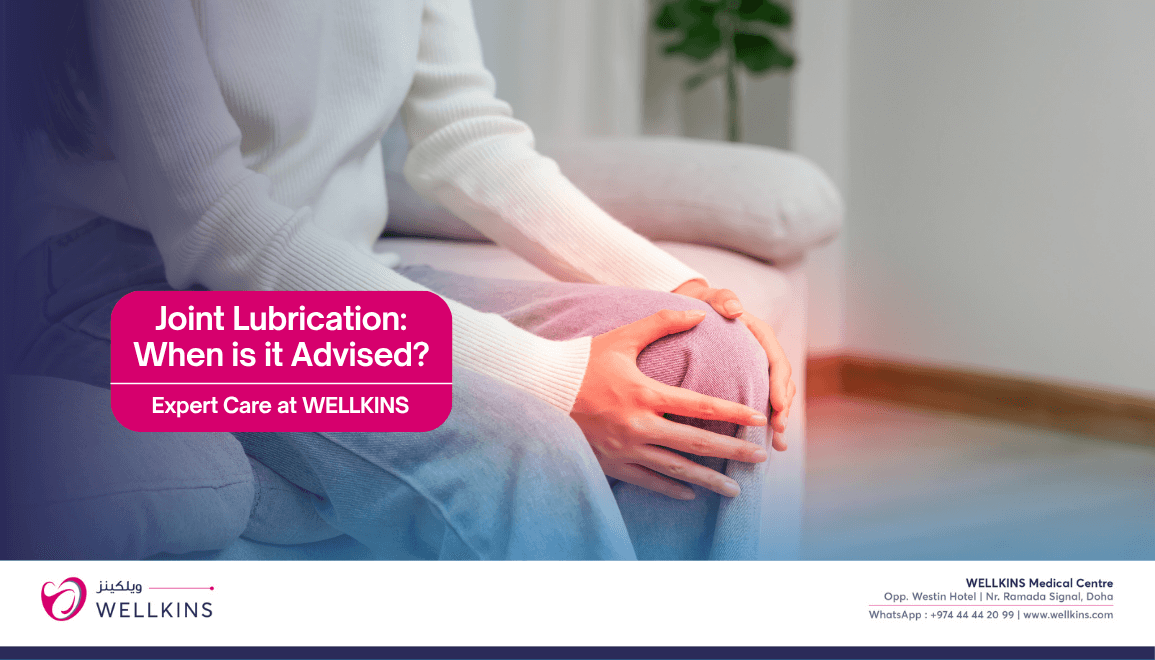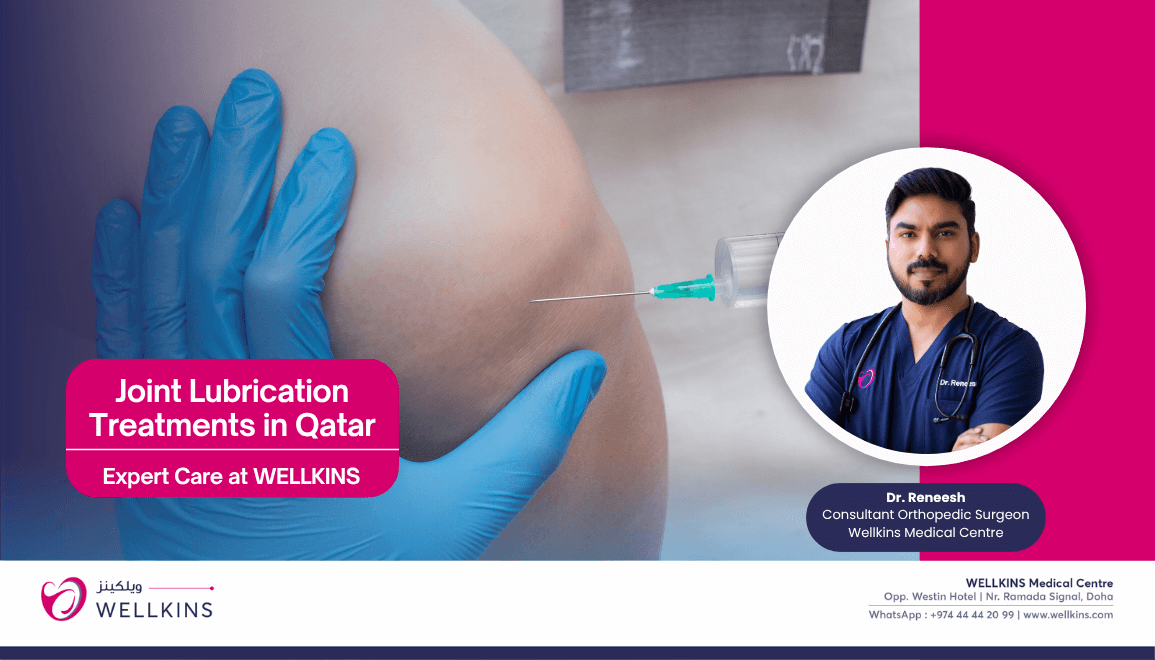Author: Dr. Reneesh (Consultant Orthopedic Surgeon – Wellkins Medical Centre)
Hyaluronic acid (HA) injection commonly known as joint lubrication or gel injection is a highly effective, minimally invasive treatment used to improve joint mobility, significantly reduce pain and delay the need for major surgical intervention. At Wellkins Medical Centre, we often recommend this proven therapy for patients seeking improved cushioning and lubrication inside their joints, especially those aiming to remain active without reliance on daily medication.
This complete guide explains when it is used, how the quick procedure is done, expected side effects, recovery timeline and the overall outlook for this restorative treatment.
“For persistent joint pain in Qatar, hyaluronic acid (HA) injections offer a targeted, non-surgical option. From an orthopedic view, this ‘gel injection’ demands careful patient selection (mild moderate osteoarthritis) and precise delivery to restore joint cushioning. Integrating HA with therapy and lifestyle changes is crucial for long term pain reduction, improved mobility and delaying surgery, rather than just masking symptoms.”

What Is Hyaluronic Acid Injection?
Hyaluronic acid is a naturally occurring, gel-like component found abundantly in the synovial fluid of healthy joints. Its critical role is providing lubrication (reducing friction) and acting as a shock absorber (cushioning impact). In conditions like osteoarthritis, the natural HA (Hyaluronic acid) in the joint fluid breaks down, leading to decreased viscosity, increased friction, chronic pain and stiffness. Injecting purified, synthetic hyaluronic acid directly into the joint space works to temporarily restore joint viscosity, improve cushioning and dramatically improve function.
Conditions Where Hyaluronic Acid Injection Can Be Given
Hyaluronic acid injections are an established part of the treatment algorithm for chronic joint pain, particularly where cartilage degeneration is present.
1. Osteoarthritis (Primary Indication)
HA injections are most commonly and successfully used in knee osteoarthritis (where the most robust evidence exists), as well as in the hips, shoulders, ankles and small-joint osteoarthritis to combat the effects of degenerative wear.
2. Post-Traumatic Joint Degeneration
These injections are often used to address accelerated wear and tear that occurs after significant sports injuries or following problems with internal joint structures like torn ligaments or meniscus that have led to early cartilage thinning.
3. Patellofemoral Pain or Chondromalacia Patella
The therapy helps improve lubrication and reduce painful friction beneath the kneecap in patients experiencing Patellofemoral Pain Syndrome or Chondromalacia Patella (softening of the kneecap cartilage).
4. Early Cartilage Wear / Mild to Moderate Degeneration
HA is an excellent conservative choice for patients with early or mild to moderate degeneration who are not yet candidates for complex surgery or who are trying to delay the need for joint replacement surgery for as long as possible.
5. Patients Not Tolerating NSAIDs or Steroids
This method is invaluable for patients who cannot safely take oral anti inflammatory drugs (NSAIDs) or steroid injections due to other health issues, such as elderly individuals, patients with diabetes, renal issues, or a history of gastric ulcers.
Note: HA is typically a second-line treatment; it is generally not the first treatment for acute, inflammatory arthritis or the most severe, bone-on bone (end-stage) arthritis, though some individuals may still experience beneficial pain relief.
Procedure: How the Injection Is Done
The procedure is quick, safe and performed directly in the clinic setting by a trained orthopedic specialist, often taking less than 15 minutes.

1. Pre-Procedure Assessment
The process begins with a thorough clinical examination and a meticulous review of X ray/MRI findings to confirm the diagnosis and ensure the correct indication for HA injection.
2. Preparation
The patient is positioned comfortably to ensure optimal joint access. The skin over the injection site is cleaned thoroughly with antiseptic solution. Local anesthesia may be used, though not always necessary, to numb the skin before needle insertion.
3. Injection Technique
A fine needle is carefully inserted into the joint space under sterile conditions. For deeper joints like the hip, ultrasound guidance is often used to ensure precise placement. The hyaluronic acid gel (usually contained in 1 pre-filled syringe) is then injected slowly to minimize pressure discomfort.
4. Post-Procedure Instructions
Patients are advised to take mild rest for 24–48 hours following the procedure. It is important to avoid heavy exercise, squatting, or high impact activities for 2–3 days to allow the gel to settle and stabilize in the joint space.
Side Effects
Hyaluronic acid injections are generally recognized as very safe with a low risk of systemic issues. Possible side effects are usually localized and temporary.
Common and Mild: These typically resolve quickly: Temporary pain at the injection site, mild swelling, a localized warmth or heaviness sensation and some joint stiffness for 24–48 hours as the gel integrates into the joint fluid.
Less Common: A temporary, acute inflammatory response known as a pseudoseptic reaction may occasionally occur, mimicking infection but resolving quickly. There may also be temporary fluid accumulation inside the joint.
Rare: The risk of true infection is very low due to sterile technique. Allergic reaction is also extremely rare with modern, highly purified HA formulations. Most symptoms settle completely with simple application of ice packs and rest.
Recovery Timeline
The benefits of HA are often not immediate but unfold over several weeks as the joint environment improves.
- Day 1–2: Mild discomfort or heaviness may be felt immediately after the injection.
- Day 3–5: This marks the beginning of gradual pain relief and improved mobility.
- Week 2–4: The maximum improvement in pain reduction and function typically appears during this period as the joint fully responds to the added lubrication.
Duration of Benefit: Relief is substantial and lasts anywhere from 6 months to 1 year, depending largely on the baseline severity of arthritis and the patient’s physical activity level.
Some patients receive a single-shot injection (which is common and convenient), while others may require a 3-injection series given weekly. Repeat injections are usually safe and administered every 6–12 months if the initial treatment proved helpful.

Advantages of Hyaluronic Acid Injection
HA injections offer clear therapeutic benefits without the risks associated with surgery or systemic medications.
- Non-surgical option: Provides effective relief without hospital admission or surgical recovery time.
- Improves joint lubrication: Directly addresses the loss of viscosity, enhancing smooth movement.
- Decreases pain and stiffness: Provides symptomatic relief, making daily activities easier.
- Enhances shock absorption: Restores the joint’s natural cushioning ability against impact.
- Improves mobility: Allows for a greater range of motion, supporting a more active lifestyle.
- No systemic side effects: Unlike long-term NSAIDs or oral steroids, HA (Hyaluronic Acid) does not carry risks for the stomach, kidneys, or cardiovascular system.
- Helps delay joint replacement: Can buy valuable time for patients needing to postpone major surgery.
Limitations
It is important to maintain realistic expectations regarding the outcome of HA (Hyaluronic Acid) therapy.
- Not effective for every patient: Individual response rates vary and not all patients achieve significant relief.
- Results may vary: The magnitude and duration of pain relief differ greatly between individuals.
- Less benefit in advanced osteoarthritis: Its effectiveness diminishes significantly in severe cases where there is advanced degeneration (bone-on-bone).
- Not a cure for arthritis: The injection provides symptom relief and joint environment enhancement, but it does not reverse the underlying arthritic disease process.
Overall Outlook
Hyaluronic acid injections or Joint Lubrication/Gel Injection are an excellent, evidence-based option for patients with mild to moderate osteoarthritis, early cartilage degeneration, or chronic joint pain who are seeking to avoid surgery and minimize medication use. At Wellkins Medical Centre, we ensure proper patient selection and accurate injection technique so that most patients experience significant improvement in pain and function. When the injections are combined with essential supporting strategies like weight management, activity modification and targeted muscle strengthening, HA (Hyaluronic acid) injections contribute significantly to achieving long-term joint health and sustained mobility under our specialized care.
To book an appointment at Wellkins Medical Centre: https://wellkins.com/orthopedics/






